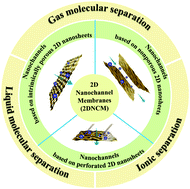Two-dimensional nanochannel membranes for molecular and ionic separations
Abstract
Two-dimensional (2D) nanosheets have emerged as promising functional materials owing to their atomic thickness and unique physical/chemical properties. By using 2D nanosheets as building blocks, diverse kinds of two-dimensional nanochannel membranes (2DNCMs) are being actively explored, in which mass transport occurs in the through-plane and interlayer channels of 2D nanosheets. The rational construction and physical/chemical microenvironment regulation of nanochannels are of vital significance for translating these 2D nanosheets into molecular separation membranes and ionic separation membranes. Focusing on the recent advances of 2DNCMs, in this review, various porous/nonporous 2D nanosheets and their derived nanochannels are first briefly introduced. Then we discuss the emerging top-down and bottom-up methods to synthesize high-quality 2D nanosheets and to prepare high-performance 2DNCMs. As the major part of this review, we focus on three types of nanochannels, which are based on nonporous nanosheets, intrinsically porous nanosheets and perforated nanosheets. The strategies for regulating the physical and chemical microenvironments in the nanochannels are emphasized. The representative applications of 2DNCMs in molecular separations (gas separation, liquid separation) and ionic separations are presented. Finally, the current challenges and future perspectives are highlighted.



 Please wait while we load your content...
Please wait while we load your content...